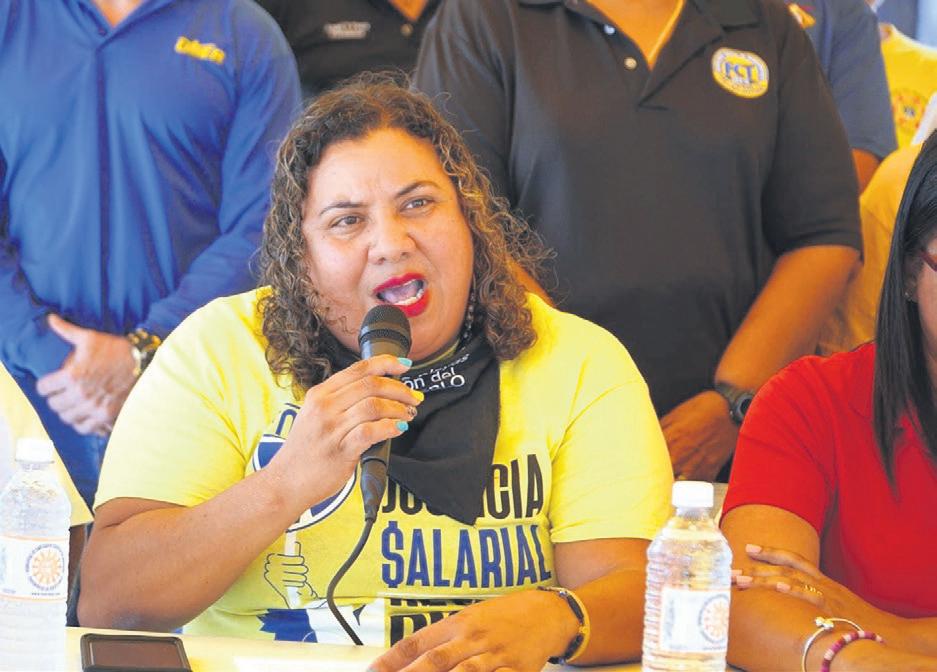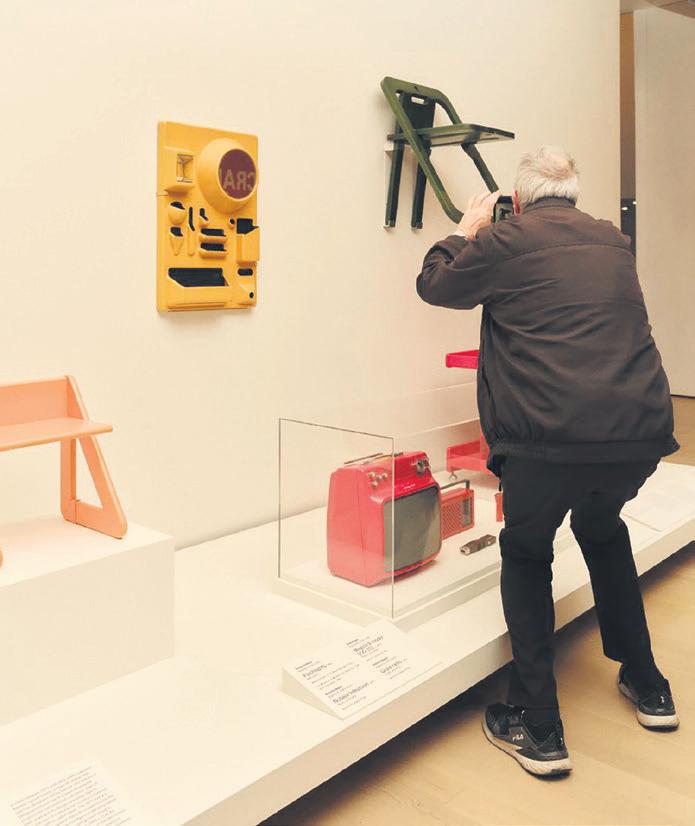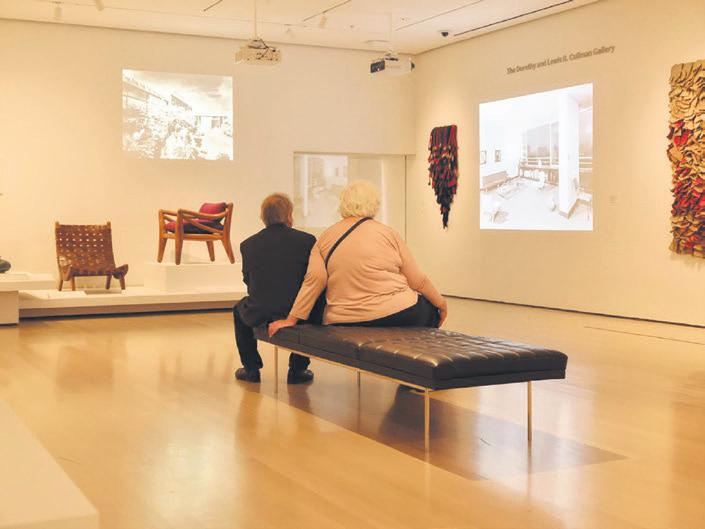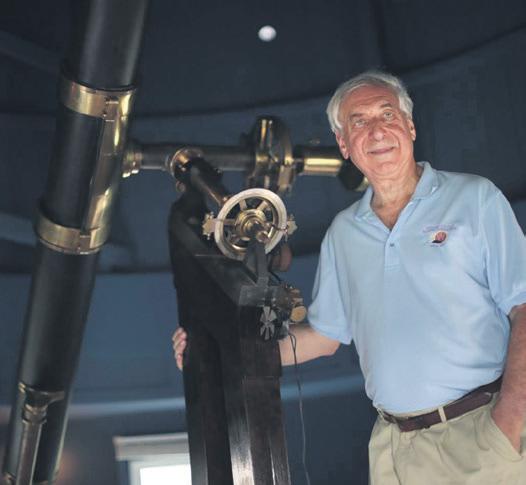
















The San Juan Daily Star, the only paper with News Service in English in Puerto Rico, publishes 7 days a week, with a Monday, Tuesday, Wednesday and Thursday edition, along with a Weekend Edition to cover Friday, Saturday and Sunday. Wind:
By THE STAR STAFFFormer President Donald Trump criticized the Biden administration’s treatment of Puerto Rico and vowed that if he is reelected president, he will stand by “the hardworking American Patriots, particularly the resilient people of Puerto Rico.”
“The extreme lengths the Biden Administration will go to, to push Americans into poverty using woke and corrupt ideals is worse than any American could have imagined,” Trump said in a letter obtained by the STAR. “While Joe has been touting the success of ‘Bidenomics,’ his Administration’s terrible policies have pushed many Puerto Ricans, for the first time in their lives, to the brink of financial ruin and




inevitable poverty. Working together, I am confident that we will return to a Nation of peace, prosperity, and unity.”
Trump’s remarks made in the letter, dated March 14, were in response to a show of support from the Puerto Rico Republican Assembly, a group comprising local conservatives that is separate from the island Republican Party Committee.
The letter sent to the group’s leader, Armando Santos, was in response to one sent by the Puerto Rico Republican Assembly letting Trump know that he has support in Puerto Rico and to learn of his views about Puerto Rico, prostatehood lawyer Gregorio Igartúa said.
“It was an exchange gesture to learn about his views on Puerto Rico,” Igartúa said.
In the letter, however, Trump thanks the group for its letter and for its steadfast support.

Former President Donald Trump, the likely Republican presidential nominee, speaks during a campaign event at the Hyatt Regency in Green Bay, Wis., on Tuesday, April 2, 2024. (Jamie Kelter Davis/The New York Times)
“It means a great deal to me,” the former president said. “May God Bless you and the wonderful people of Puerto Rico.”
The letter appears to reflect a change from Trump’s past views about Puerto Rico. It was in 2020 when Miles Taylor, a former Department of Homeland Security (DHS) chief of staff under Trump, said that the then-president asked him and other officials in 2018 whether the U.S. could swap Greenland for Puerto Rico. The exchange, Taylor said, happened in August 2018 before DHS officials went on a disaster recovery trip to the island after it had been devastated by hurricanes Irma and Maria in 2017.
However, in 2021 Trump approved for Puerto Rico nearly $13 billion in federal disaster funding to repair the island’s electrical and education infrastructure three years after Hurricane Maria struck.
The Integrated Transportation Authority (ATI by its Spanish initials) has scheduled public meetings for April 15 and April 16 to discuss the proposed extension of the Urban Train (Tren Urbano).
Transportation and Public Works (DTOP) Secretary Eileen Vélez Vega and ATI’s Josué Menéndez Agosto said earlier this week that the objective of the two sessions is to promote citizen participation in public transit issues and offer the population an opportunity to ask questions and share opinions.
“Active community participation is essential for developing public transportation projects that respond to our society’s needs,” the DTOP secretary said. “We are committed to listening to citizens’ voices and working together toward a more sustainable and efficient mobility future for San Juan and Puerto Rico.”
During the Urban Train extension analysis meetings in San Juan, officials will provide information on the preliminary
concepts of the project, followed by a detailed explanation of the evaluation process and the results achieved to date.
The Tren Urbano: Northwest Extension Alternatives Analysis study will evaluate various transit options to extend the Urban Train from the Sagrado Corazón station in Santurce to the northwest. The analysis examined modes such as bus rapid transit (BRT), light rail transit (LRT), or heavy rail transit (HRT) similar to the currently operating Urban Train, and evaluates their feasibility and effectiveness based on factors such as travel time, demand, operating costs, environmental impact and community needs.
ATI and a task force designated for the extension have developed and evaluated plans to expand train services to the northwest of San Juan.
The meeting on April 15 will start at 6 p.m. in the José “Pepito” Figueroa Room at the Puerto Rico Conservatory of Music in Miramar. The April 16 meeting will start at 5 p.m. and will take place in the Arts Pavilion, Barat Sur Building, at Universidad de Sagrado Corazón in Santurce.

Gubernatorial primary candidate Jenniffer González Colón said her proposal for the island’s energy sector is focused on building a system that attracts economic investment, allows lowering costs for small and midsize merchants, manufacturing and consumers, and eliminates the impact on the environment of obsolete or inefficient fuel plants.
(Comité Jenniffer González Colón) By THE STAR STAFFGubernatorial primary candidate Jenniffer González Colón on Thursday presented her Action for Puerto Rico proposals for the energy sector. She said the program is focused on building a system that attracts economic investment, allows lowering costs for small and midsize merchants, manufacturing and consumers, and eliminates the impact on the environment of obsolete or inefficient fuel plants.
“The government has to be part of the solution for the stability and security of the electrical grid, taking a more active role, contributing directly to reducing the load on the system and producing lower cost energy to reintegrate into the system and thus save money for the people,” González Colón said in a written statement.
The modernization of the electrical grid has been a priority for González Colón, the sitting resident commissioner and a New Progressive Party candidate for the governorship, as a congresswoman, she said, by securing the historic federal allocation to rebuild the entire electrical system, and supervising the disbursement and use of those funds as a candidate for governor.
“If the Financial Oversight and Management Board’s proposal materializes, residential customers will be impacted with over $20 more on their bill each month -- only with the Debt Adjustment Plan (PAD) charge,” González Colón said. “We must add the calculation of pensions and their division and allocation of payment sources. That is totally unacceptable to us. We come from several years with marked excesses in collections in the Treasury.”
She said her plan would promote a coherent energy policy to achieve better coordination and execution by the government components. She proposes conducting an audit and establishing an immediate implementation plan for all post-Maria federal allocations aimed at rebuilding the electric grid.
“The historic allocation of federal funds to rebuild the electric grid has had no tangible impact,” González Colón said. “The projects appear to be in very early stages, despite so many years having passed since the funds were allocated.”
Her plan calls for an end to the practice of hiring-related companies or subsidiaries that unnecessarily increase costs to the people.
Energy companies will be required, in order to enter into a contract with a related company, to prove that there is no company in Puerto Rico that can provide the services and that there is no other company at a national or global level that can offer services at a similar cost.
Under this guideline, for example, Centurion Group would not be paid $60 million for a vegetation management and maintenance contract with LUMA Energy, when that compa-
ny needed to obtain the personnel to provide the services when it was awarded the contract, González Colón noted.
She also proposed strengthening the stability and security of the electrical grid, turning the government into an actor, instead of a spectator, in compliance with the Puerto Rico Energy Policy Law (Law 17-2019).
Law 16-2019, meanwhile, requires the integration of massive renewable energy into the energy grid. In addition to supporting the construction of large-scale green energy projects, as well as distributed generation projects, the island government has to be part of the solution, the gubernatorial hopeful said.
She also proposes seeking legislative action to make the necessary investments to strengthen the grid, and ensure a constant energy supply with a diversity of fuels during the energy transition.
“The use of natural gas in a transition to renewables is not an impediment to the development of renewables,” González Colón said. “Across the nation, this has not stopped the development of renewable energy on an industrial or residential scale.”
Rep. Domingo Torres García gave the executive branch 10 days to provide information on salary increases given to employees in positions of trust.
He made the request following reports that employees in positions of trust in the government received salary hikes.
“It is extremely alarming that the Office of Management and Budget has approved increases to trust employees when the Fi-
nancial Oversight and Management Board [FOMB] has not yet authorized or evaluated the Classification and Remuneration Plan for these employees,” said Torres García, who chairs the Labor Affairs Committee in the island House of Representatives. “Even the executive director of the Office of Administration and Transformation of Human Resources has admitted that the FOMB has not yet expressed itself about this plan.”
The Popular Democratic Party lawmaker said the increase leaves a lot left to say, es-

pecially when career government employees have not seen their own salaries raised. “We are still waiting for the guidelines so that career employees can go from the minimum, to the medium and maximum type. That is to say, the government has dragged its feet for career employees, but has been agile in raising the salaries of trust employees.”
The Labor Affairs Committee will grant 10 business days to the Office of Management and Budget and the Office of Human Resources Administration and Transformation to provide the information.
“There cannot be two versions of the government, one that establishes extremely high standards so that career employees can obtain better remuneration and a vision with extremely flexible standards so that trust employees receive increases without control,” Torres García said. “It is time for public employees to be respected, and if increases are to be granted, they must be on equal terms under the uniform process contained in the Classification and Remuneration Plans.”
Gov. Pedro Pierluisi Urrutia justified the recent salary increase granted to central government trust employees. He insisted that the action responds to the fact that supervisors, everywhere, must earn more than those they supervise, something that on many occasions was not happening in the government.

“Definitely, it is justified, but it is still missing,” the governor said. “More adjustments are needed because supervisors have to earn more than those they supervise and we have adjusted the salaries of the vast majority of career government officials. We are talking about more career officials in the government; they are more than 95% of public employees in Puerto Rico. More than 95% of public employees in Puerto Rico are permanent employees, permanent public servants of the government. There is a supervisory management staff, it is a basic concept of administration that they must earn more, have a higher compensation than the staff that they are supervising and we have been in the process of doing that within the budget that the government has.”
Given the recent cases of attacks and crimes against uniformed personnel, the island Senate in its ordinary session on Thursday approved a bill that proposes establishing the BLUE alert.
Senate Bill 1404, authored by Sen. Carmelo Ríos Santiago, seeks to develop the Enabling Law to Implement the BLUE Alert Plan, in order to have a mechanism that facilitates the search and capture of those suspected of threatening, injuring or killing police officers in the fulfillment of duty. The mechanism would also expedite the search and recovery of those uniformed personnel who disappeared in connection with their official duties.
According to the bill’s preamble, the BLUE Alert seeks to be a prevention system like other systems already used in Puerto Rico, such as the Ashanti, Silver, and Rosa Alert, among others. In addition, the island has a self-sufficient
platform capable of quickly and effectively transmitting any emergency signal, with the potential of avoiding officer fatalities, the preamble says.
The legislation was addressed in a Feb. 21 public hearing of the upper chamber’s Public Safety andVeterans Affairs Committee, in which the Department of Public Safety, Bureau of Emergency Management and Disaster Administration, and Department of Transportation and Public Works (DTOP) showed no qualms about it becoming law.
Also during the public hearing, the Office of Management and Budget indicated that the impact, if any, would be minimal, since other alert plans already exist. However, if there is any impact, the measure provides mechanisms to authorize the DTOP to receive, request, accept, write and submit proposals for donations and contributions of resources from public and private sources.

 By THE STAR STAFF
By THE STAR STAFF
Afederal grand jury indicted José Martínez Serrano and Edwin Yadiel Flores Tavárez for kidnapping resulting in death and possession and use of a firearm in a violent crime, in a case involving the killing of two teenage girls whose bodies were found at a beach in Piñones in the northeast coastal town of Loíza last summer, the U.S. Attorney for the District of Puerto Rico W. Stephen Muldrow announced Thursday.
“These defendants brutally kidnapped and murdered two young women,” Muldrow said in a written statement.
According to the indictment, the kidnapping occurred on July 25, 2023, where the defendants, with the help of others, kidnapped and murdered Tanisha de Jesús Curet, 15, and Naya Ramos López, 13. The
crime involved the use of a 2022 Ford EcoSport and a cell phone, the indictment said.
The two girls, who were close friends, had been reported missing in the municipality of Arroyo. Their bodies were found in the beach area of Piñones in a Toyota Tacoma that was stolen in a carjacking from a merchant in Ponce.
Joseph González, special agent in charge of the FBI’s San Juan field office, thanked the Puerto Rico Police and the Carolina Municipal Police for their support.
“Our commitment has been to bring the criminals responsible to justice,” González said.
The defendants face life in prison if convicted. The investigation is being conducted by the FBI, the Puerto Rico Police and the Carolina Municipal Police. The case is being prosecuted by Assistant District Attorney Julián Radzinschi.
Average hourly wage increased to $16.40 per hour last yearBy THE STAR STAFF
According to the recent edition of the 2023 Jobs and Wages by Occupation survey, a product of a collaborative effort between the island Department of Labor and Human Resources (DTRH by its Spanish initials) and its federal counterpart, the average hourly wage increased to $16.40, while the median wage also increased to $12.09, DTRH Secretary Gabriel Maldonado González said Thursday.
The official said that for the year 2022, those figures stood at $15.54 and $11.29 per hour, respectively. The average annual salary for all occupations, meanwhile, increased to $34,120,
while in 2022 it was $32,330.
“In line with the economic rebound that Puerto Rico is experiencing, tied to the lowest unemployment rate in history, the highest labor participation in over a decade and the highest level of employment in the last 15 years, this new publication also reflects that, on average, Puerto Ricans are earning more money than before,” Maldonado González said in a written statement. “When we compare the results of 2023 with the survey corresponding to the year 2021, we see an increase of 12% in the average wage and 11% in the median wage, which in addition to the aforementioned is also the product of two increases to the applicable minimum wage, currently at $9.50
per hour, while fierce competition persists between employers in all industries to attract and retain talent that motivates them to offer a better compensation and benefits package.”
At the industry level, virtually all economic sectors have experienced significant improvements in salary levels when compared to 2021, the DTRH chief noted.
“For example, construction increased by 16 percent, while manufacturing and the information sector increased by 11 percent and 20 percent, respectively,” he said. “This upward trend in wages, in turn, mitigates the impact of inflation that we experienced in recent years and that has been stabilizing recently.”
President Joe Biden told Prime Minister Benjamin Netanyahu of Israel on Thursday that strikes on aid workers “are unacceptable” and he appeared to threaten to condition future support for Israel on how it addresses U.S. concerns about civilian casualties and the humanitarian crisis in the Gaza Strip, the White House said.
During a lengthy and evidently tense call with Netanyahu, Biden expressed his frustration over the killing of seven aid workers by Israeli military forces and what he sees as the broader disregard for the suffering of innocents in Gaza even as he expressed support for Israel’s right to respond to Hamas for the Oct. 7 terrorist attack.

President Joe Biden greets guests at a reception celebrating Eid-al-Fitr in the East Room of the White House in Washington, May 1, 2023. Biden told Prime Minister Benjamin Netanyahu of Israel on Thursday that strikes on aid workers “are unacceptable” and he appeared to threaten to condition future support for Israel on how it addresses U.S. concerns about civilian casualties and the humanitarian crisis in the Gaza Strip. (Yuri Gripas/The New York Times)
“President Biden emphasized that the strikes on humanitarian workers and the overall humanitarian situation are unacceptable,” the White House said in a sharp statement. “He made clear the need for Israel to announce and implement a series of specific, concrete, and measurable steps to address civilian harm, humanitarian suffering, and the safety of aid workers. He made clear that U.S. policy with respect to Gaza will be determined by our assessment of Israel’s immediate action on these steps.”
In saying that U.S. policy “will be determined” by Netanyahu’s response to Biden’s concerns, the president tied his support for the war more explicitly than ever before to Israeli conduct going forward. But the White House statement stopped short of directly saying the president would halt arms supplies or impose conditions for their use, as more and more Democrats have urged him to do.
The president has long resisted leveraging arms to influence Israel’s conduct of the war, with aides arguing that many of the munitions sent are air defense missiles. But even some of Biden’s close Democratic allies have increasingly come around to the view that Washington should exercise more control over the weaponry, including Sen. Chris Coons, a fel-
low Democrat from Delaware and confidant of the president.
“I think we’re at that point,” Coons said on CNN on Thursday morning, adding that if Netanyahu were to order the Israeli military into the southern Gaza city of Rafah in force and “drop thousand-pound bombs and send in a battalion to go after Hamas and make no provision for civilians or for humanitarian aid, that I would vote to condition aid to Israel.”
Some of former President Barack Obama’s old team have grown more outspoken in castigating Biden for not doing more to restrain Netanyahu, who goes by the nickname Bibi, and the Israel Defense Forces, or IDF, saying that the president’s expressed outrage was meaningless otherwise.
“The U.S. government is still supplying 2 thousand pound bombs and ammunition to support Israel’s policy,” Ben Rhodes, a former deputy national security adviser to Obama, wrote on social media. “Until there are substantive consequences, this
Atención empleados que aportan a planes 401 K o 1165 E, que por motivos de jubilación o pérdida de empleo tienen que transferir las acumulaciones de su retiro a una cuenta cuali cada, En Coop Las Piedras Insurance Agency te ofrecemos la oportunidad de orientarte y ayudarte con el producto que más se ajuste a sus necesidades. Infórmese bien antes de mover su dinero. ¡Llámanos para una orientación personalizada!.
Coop Las Piedras Insurance Agency, tu agencia de seguros, ofreciéndote protección total…
outrage does nothing. Bibi obviously doesn’t care what the U.S. says, its about what the U.S. does.”
Jon Favreau, a former chief speechwriter for Obama, was even more derisive of Biden. “The president doesn’t get credit for being ‘privately enraged’ when he still refuses to use leverage to stop the IDF from killing and starving innocent people,” he wrote. “These stories only make him look weak.”
The killing of the World Central Kitchen workers has inflamed the tensions between Washington and Jerusalem at a time when Biden has complained that Israel has not done enough to curb the killings of civilians or facilitate the provision of humanitarian aid into Gaza. Biden called himself “outraged and heartbroken” over the incident and made a point of calling José Andrés, the celebrity chef who founded World Central Kitchen, to express his condolences.
The seven were killed by three successive strikes on three cars traveling along a road in Gaza. Israeli officials have called the episode a tragic mistake based on a misidentification of the vehicles, but have not explained more explicitly how it happened. The cars were marked with World Central Kitchen logos, although the attack took place at night. Andrés has said his organization kept in touch with Israeli officials about travel plans.
As of Thursday morning, the Israelis had not yet communicated any initial findings of their promised investigation into the strike to the United States, according to a senior Biden administration official who spoke on the condition of anonymity to detail internal conversations.
Some Palestinian advocates reacted with aggravation to Biden’s expression of outrage over the deaths of the aid workers because in their view he has not responded with nearly enough indignation over the killing of more than 30,000 people living in Gaza, most of them civilians.
The president is evidently coming under pressure even from within his own family. Biden told Muslim community leaders at the White House on Tuesday evening that first lady Jill Biden had weighed in, telling him, “Stop it, stop it now, Joe.”

Hundreds of thousands of voters turned out in New York for the Democratic and Republican primaries on Tuesday, where President Joe Biden and former President Donald Trump won overwhelming victories.
But the impact of an organized protest vote in the state, encouraged as a way for voters to register their disapproval with Biden’s handling of the war in Gaza, remains unclear and may not be known for days.
While Biden and Trump scored yawning leads in New York — as well as in primaries in Wisconsin, Rhode Island and Connecticut — small but significant protest votes in both parties have persisted.
New York does not have an “uncommitted” option, so organizers of an anti-Biden protest vote in the state instead urged voters in the Democratic primary to leave their ballots blank.
Blank ballots have not been reported in the initial, unofficial results of the primary, which showed Biden with more than 90% of tallied votes. A spokesperson for New York’s Board of Elections said the tally of blank ballots would be public within two weeks.
In the Republican primary, Trump had above 80% of the vote, while Nikki Haley had
13% and Chris Christie, a former governor of New Jersey, scored 4% of the vote. He dropped out of the race in January.
Trump took at least 75% of the vote in every state as of 8 a.m. Eastern time on Wednesday. But Haley, who dropped out of the race early last month, still took at least 10% of the vote in all four states, a sign of lingering
discontent in the Republican Party with Trump’s candidacy. Connecticut was Trump’s weakest performance, taking under 78% of the vote, while Haley took about 14%.
Biden also won at least 80% of the vote in every primary as of 8 a.m. The “uncommitted” option took between 8% and 15% of the vote in the states where that was an option.

In Rhode Island, 14.9% of voters chose the “uncommitted” ballot option, or about 3,750 votes, with turnout on the Democratic side roughly a quarter of that in 2020.
Here’s what else to know:
— Voters in Wisconsin approved two constitutional amendments that will forbid officials from accepting donations of money or staffing to help run elections. The questions were placed on the state’s primary ballot by the Republican-controlled Legislature.
— A new Wall Street Journal poll released Tuesday finds that Trump leads Biden in six battleground states — Arizona, Georgia, Michigan, Nevada, North Carolina and Pennsylvania. Biden leads in Wisconsin, according to the poll, but only when the test ballot includes third-party and independent candidates. In a head-to-head matchup, they are tied in Wisconsin. Several of the leads are within the margin of error of plus or minus 4 percentage points.
— Nebraska Gov. Jim Pillen, a Republican, and Trump threw their support behind a measure to change the district-based system for presidential elections in the state to a “winner takes all” system that would award all electoral votes to the statewide winner. Biden was able to win one electoral vote in Nebraska in 2020 under the current rules, the first time a Democrat had done so since 2008.
The son of a politician from the Dominican Republic was fatally shot outside a gas station in Houston on Monday night in what the police said they believed was a “targeted” drive-by shooting.
The Houston Police Department on Wednesday identified the man who was killed as Luis Alfredo Pacheco Rojas, 34, son of Alfredo Pacheco, president of the Chamber of Deputies of the Dominican Republic. Another 29-year-old man who was injured by gunfire in the attack had not yet been publicly identified.
The incident began around 7 p.m. Monday, when Luis Pacheco and three men in a black Cadillac Escalade stopped at a gas station in southeast Houston, according to the Police Department.
The four men went inside the gas station, and immediately afterward they returned to the Escalade.
Assistant Chief Adrian Rodriguez of the Police Department initially said at a news conference Monday that at that point, four other men armed with what police called long guns arrived in two vehicles — a silver Dodge Charger and a silver Mercedes-Benz — and began shooting at the Escalade.
On Tuseday, the Police Department clarified in a statement that only three attackers were involved — two of whom had been in the Dodge and another in the Mercedes.
Pacheco was shot and later pronounced dead at a hospital, according to the Police Department. The other man who was injured by gunfire was “conscious and breathing” at a hospital Monday night, Rodriguez said.
“I do believe that these individuals in the Escalade were targeted,” Rodriguez said Monday.
Detectives were working to determine a possible motive for the shooting, the Police Department said. Authorities were also searching for the gunmen who fled the gas station after the shooting. Rodriguez described them as Hispanic men in their 20s or 30s.
The Police Department on Tuesday released photos of the gunmen from surveillance footage.
In a post on X on Tuesday, Alfredo Pacheco said his son had been living out of the country.
“I sincerely thank friends and colleagues for their solidarity in this difficult time,” he wrote in the post.
Alfredo Pacheco has worked in politics since the 1990s, and since 2020, he has led the Chamber of Deputies, part of the legislative branch in the Dominican Republic. He has
also been a member of the National Council of the Judiciary since 2020, the body responsible for evaluating and electing judges of the Supreme Court of Justice, the Superior Electoral Court and the Constitutional Court.
A voter checks in at a polling place at the Carver Academy on primary election day in Milwaukee, Wis., on April 2, 2024. (Jim Vondruska/The New York Times)Wall Street’s main stock indexes advanced on Thursday as recent economic reports boosted the prospect of monetary policy easing later this year, while investors awaited policymakers to offer clues on the timing of the cuts.
Initial data on state unemployment benefits claims on Thursday rose to 221,000 for the week ended March 30 compared with an estimate of 214,000 from economists polled by Reuters, which indicates a slowing labor market and supports the Federal Reserve’s target of three rate cuts this year.
In the previous session, data on slowing U.S. services sector activity and statements from Federal Reserve officials, including from Chair Jerome Powell, had led the S&P 500 and the Nasdaq to close higher.
While policymakers generally agreed that rates could fall later this year, Powell said this would happen only when they “have greater confidence that inflation is moving sustainably down” to the Fed’s 2% target.
“People were getting a little bit nervous about rate cuts not happening, but (Powell’s) comments yesterday kind of said let’s not worry too much about that,” said Joe Saluzzi, partner, co-founder and co-head of equity trading at Themis Trading.
“As long as there is a path to rate cuts, it’s actually not a bad thing they’re not cutting rates right now.”
Equities fell earlier this week following some strong economic reports, including manufacturing activity and job openings data that raised doubts about the three rate cuts widely priced in for the year.
Money markets are currently seeing a near 60% chance of at least a 25 basis point rate cut in June, according to the CME Group’s FedWatch tool.
Investors will be closely monitoring comments from Fed policymakers, including Richmond Fed President Thomas Barkin, a voting member, and his Cleveland counterpart Loretta Mester, for further clues on the monetary policy, before the key nonfarm payrolls data on Friday.
Economists polled by Reuters expect the nonfarm payrolls for March to fall to 200,000 from 275,000 in February, while anticipating unemployment rate to remain steady at 3.9%.
At 11:27 a.m. ET, the Dow Jones Industrial Average was up 144.79 points, or 0.37%, at 39,271.93, the S&P 500 was up 32.63 points, or 0.63%, at 5,244.12, and the Nasdaq Composite was up 128.80 points, or 0.79%, at 16,406.26.
Ten of the 11 major S&P 500 sectors were trading higher, with the rate-sensitive real estate leading advances, up around 1.0%.
Meta Platforms rose highest among megacap stocks, up 2.9% after Jefferies raised its price target on the social media giant.
Alphabet, however, slipped 0.8% after a Reuters report that the Google-parent has been talking to its advisers about the possibility of making an offer for HubSpot. Shares of the cloud-based CRM platform were up over 9%.
Levi Strauss jumped 15.7% after the apparel maker

raised its annual profit forecast, citing savings from its recent cost-cutting measures and fewer discounts.
Lamb Weston dropped 20.3% after the frozen goods maker trimmed its full-year revenue and adjusted profit guidance.
Advancing issues outnumbered decliners by a 3.98-to-1 ratio on the NYSE by a 2.35-to-1 ratio on the Nasdaq.
The S&P index recorded 49 new 52-week highs and 3 new lows, while the Nasdaq recorded 83 new highs and 46 new lows.




When the largest earthquake in Taiwan in a half-century struck off its east coast, the buildings in the closest city, Hualien, swayed and rocked. As more than 300 aftershocks rocked the island over the next 24 hours to Thursday morning, the buildings shook again and again.
But for the most part, they stood.
Even the two buildings that suffered the most damage remained largely intact, allowing residents to climb to safety out the windows of upper stories. One of them, the rounded, red brick Uranus Building, which leaned precariously after its first floors collapsed, was mostly drawing curious onlookers.
The building is a reminder of how much Taiwan has prepared for disasters like the magnitude 7.4 earthquake that jolted the island Wednesday. Perhaps because of improvements in building codes, greater public awareness and highly trained search-andrescue operations — and, likely, a dose of good luck — the casualty figures were relatively low. By Thursday, 10 people had died and more than 1,000 others were injured. Several dozen were missing.
“Similar level earthquakes in other societies have killed far more people,” said Daniel Aldrich, a director of the Global Resilience Institute at Northeastern University. Of Taiwan, he added: “And most of these deaths, it seems, have come from rock slides and boulders, rather than building collapses.”
Across the island, rail traffic had resumed by Thursday, including trains to Hualien. Workers who had been stuck in a rock quarry were lifted out by helicopter. Roads were slowly being repaired. Hundreds of people were stranded at a hotel near a national park because of a blocked road, but they were visited by rescuers and medics.
On Thursday in Hualien city, the area around the Uranus Building was sealed off, while construction workers tried to prevent the leaning structure from toppling completely. First they placed three-legged concrete blocks that resembled giant Lego pieces in front of the building, and then they piled dirt and rocks on top of those blocks with excavators.
“We came to see for ourselves how serious it was, why it has tilted,” said Chang Mei-chu, 66, a retiree who rode a scooter with her husband Lai Yung-chi, 72, to the building on Thursday. Lai said he was a re-

Search and rescue teams remove a body from the damaged Uranus Building following a magnitude-7.4 earthquake in Hualien, Taiwan, on Wednesday, April 3, 2024. The quake killed nine and injured more than 1,000 others, stretching an expert quake response system that has served as a model in other places. (Lam Yik
Fei/The New York Times)
tired builder who used to install power and water pipes in buildings, and so he knew about building standards. The couple’s apartment, near Hualien’s train station, had not been badly damaged, he said.
“I wasn’t worried about our building, because I know they paid attention to earthquake resistance when building it. I watched them pour the cement to make sure,” Lai said. “There have been improvements. After each earthquake, they raise the standards some more.”
Requirements for earthquake resistance have been built into Taiwan’s building codes since 1974. In the decades since, the writers of Taiwan’s building code also applied lessons learned from other major earthquakes around the world, including in Mexico and Los Angeles, to strengthen Taiwan’s code.
After more than 2,400 people were killed and at least 10,000 others injured during the Chi-Chi quake of 1999, thousands of buildings built before the quake were reviewed and reinforced. After another strong quake in 2018 in Hualien, the government ordered a new round of building inspections. Since then, multiple updates to the building code have been released.
“We have retrofitted more than 10,000 school buildings in the last 20 years,” said Chung-Che Chou, the director general of the
National Center for Research on Earthquake Engineering in Taipei.
The government had also helped reinforce private apartment buildings over the past six years by adding new steel braces and increasing column and beam sizes, Chou said. Not far from the buildings that partially collapsed in Hualien, some of the older buildings that had been retrofitted in this way survived Wednesday’s quake, he said.
The result of all this is that even Taiwan’s tallest skyscrapers can withstand regular seismic jolts. The capital city’s most iconic building, Taipei 101, once the tallest building in the world, was engineered to stand through typhoon winds and frequent quakes. Still, some experts say that more needs to be done to either strengthen or demolish structures that don’t meet standards, and such calls have grown louder in the wake of the latest earthquake.
Taiwan has another major reason to protect its infrastructure: It is home to the majority of production for the Taiwan Semiconductor Manufacturing Co., the world’s largest maker of advanced computer chips. The supply chain for electronics from smartphones to cars to fighter jets rests on the output of TSMC’s factories, which make these chips in facilities that cost billions of dollars to build.
The 1999 quake also prompted TSMC to take extra steps to insulate its factories from earthquake damage. The company made major structural adjustments and adopted new technologies like early warning systems. When another large quake struck the southern city of Kaohsiung in February 2016, TSMC’s two nearby factories survived without structural damage.
Taiwan has made strides in its response
to disasters, experts say. In the first 24 hours after the quake, rescuers freed hundreds of people who were trapped in cars in between rockfalls on the highway and stranded on mountain ledges in rock quarries.
“After years of hard work on capacity building, the overall performance of the island has improved significantly,” said Bruce Wong, an emergency management consultant in Hong Kong. Taiwan’s rescue teams have come to specialize in complex efforts, he said, and it has also been able to tap the skills of trained volunteers.
Taiwan’s resilience also stems from a strong civil society that is involved in public preparedness for disasters.
Ou Chi-hu, a member of a group of Taiwanese military veterans, was helping distribute water and other supplies at a school that was serving as a shelter for displaced residents in Hualien. He said that people had learned from the 1999 earthquake how to be more prepared.
“They know to shelter in a corner of the room or somewhere else safer,” he said. Many residents also keep a bag of essentials next to their beds, and own fire extinguishers, he added.
Around him, a dozen or so other charities and groups were offering residents food, money, counseling and child care. The Tzu Chi Foundation, a large Taiwanese Buddhist charity, provided tents for families to use inside the school hall so they could have more privacy. Huang Yu-chi, a disaster relief manager with the foundation, said nonprofits had learned from earlier disasters.
“Now we’re more systematic and have a better idea of disaster prevention,” Huang said.
Around 5 p.m. Monday, Israeli warplanes streaked across the Syrian border, striking an embassy building in Damascus and killing a cadre of senior Iranian military commanders with the kind of pinpoint accuracy that has earned Israel’s military fear and respect across the Middle East.
Several hours later, the same Israeli military rained missiles on an aid convoy on a coastal road in the Gaza Strip, a botched operation that left seven foreign aid workers dead and Israel’s reputation in tatters. Its leaders were forced to admit to a string of lethal mistakes and misjudgments.
How one of the world’s best-equipped, best-trained militaries could pull off a dangerous strike on foreign soil and then stumble with such tragic consequences in Gaza raises a raft of hard questions — not least how the Israeli military enforces the rules of engagement in its war against Hamas.
Israeli officials attribute the strike on the aid group, World Central Kitchen, to factors common in war: a complex battlefield, where combatants mix with civilians; reduced visibility because it was nighttime; and a moving target, which gave the commanders only minutes to make decisions.
The Damascus raid was the mirror image: a meticulously planned, precisely timed operation against a stationary target, most likely approved at the highest levels of the Israeli military and government.
Details provided by members of Iran’s own Revolutionary Guard suggest Israel had intelligence up to the minute of the strike, including when the ambassador and other civilians had left the building and that key Iranian commanders were there to meet Palestinian militants to discuss the war in Gaza.
In contrast, military analysts in Israel and the United States said Israel’s explanations do not fully account for what hap-
pened along the Gaza coast Monday night. The accidental killing of the aid workers, several said, was the predictable result of a shoot-first style of engagement Israeli troops have used in their military campaign since the Hamas attacks of Oct. 7.
“It was not a question of accuracy because it was highly accurate,” said Yagil Levy, a professor and expert on the Israeli military at the Open University of Israel. “It was not a question of negligence, because the action was taken after close consideration of the circumstances.”
“In Gaza, the IDF is committed to killing as many Hamas fighters as possible,” he continued, using an acronym for the Israeli military. “In many cases, targeting Hamas combatants is at odds with the principle of respecting the immunity of civilians.”
Levy said aid convoys in Hamas-controlled Gaza were often guided by armed locals with ties to the militants to prevent their supplies from being damaged or stolen. For the Israeli military, which uses drones to monitor the convoys, that raises the prospect that some of the passengers constitute legitimate combat targets.
The Israelis struck the World Central Kitchen convoy after it had delivered supplies from a jetty to a warehouse. The three vehicles were traveling back when the Israeli military launched three strikes. Two of the vehicles were destroyed, and a third had a gaping hole in its roof next to the seal that identified it as belonging to World Central Kitchen, the charity founded by chef José Andrés.
Andrés said the military would have known his workers’ locations because it was in communication with them. “This was not just a bad-luck situation where, ‘oops,’ we dropped the bomb in the wrong place,” he said to Reuters.
“It was a mistake that followed a misidentification, at night during the war in a very complex condition,” the Israeli military chief of staff, Lt. Gen. Herzi Halevi, said Tuesday. Prime Minister Benjamin Netanyahu vowed, “We will do everything so that this thing does not happen again.”

ing killed at least 182 people, including 13 U.S. troops, during the frantic U.S. withdrawal from the country.
Under acute pressure to avert another attack, the U.S. military believed it was tracking a terrorist who might imminently detonate another bomb. Instead, it killed an Afghan aid worker and nine members of his family.
“We had just lost troops to a bomb, and there was fear of another bomb,” said John Nagl, a professor of war-fighting studies at the U.S. Army War College in Carlisle, Pennsylvania. “The Israelis felt their troops were in danger. The desire to protect the troops overrode the decision to protect civilians.”
By contrast, Nagl said, the strike on the embassy in Damascus was “flawlessly executed.” The Israelis, he said, “controlled the time and place of the action, and it was on a fixed site. The hard part of that mission was the intelligence gathering, not the military operation.”
This is not the first time Israeli soldiers have accidentally hit civilians. In December, they mistakenly shot dead three Israeli hostages in Gaza City, causing outrage in Israel. In January, an Israeli tank opened fire on a convoy for Paltel, the largest telecommunications company in Gaza, killing two technicians, according to the company. The Israeli army said it was investigating the incident but has not announced any conclusions.
Those accidents only add to the pressure facing Israel in light of the spiraling death toll in Gaza. According to health officials in the Hamas-controlled enclave, more than 32,000 people have been killed in six months of war, many of them children. The Gaza Health Ministry’s tally includes both civilians and combatants.
Nagl said he believed the Israeli military should tighten its rules of engagement — the conditions under which soldiers are permitted to open fire — particularly because the number of Hamas fighters in the civilian population had declined since the fighting began in October. Israeli experts said the Israeli military should learn how to better identify targets.
“Tens of thousands of targets have been successfully identified,” said Michael B. Oren, a former Israeli ambassador to the United States who once served as a spokesperson for the Israeli military. “The WCK workers, tragically, weren’t. The IDF will investigate, conclude how and why the error occurred and draw lessons that will help prevent similar errors in the future.”
But Oren and other Israelis pushed back on the suggestion that the Damascus raid was a useful comparison.
“Outside of Gaza — in Syria, for example — Israel faces far fewer complexities,” he said. “Targets are much more easily identified and eliminated, with far less scope for human error.”
Some likened the episode to an errant U.S. drone strike in Afghanistan in 2022 that killed 10 innocent people, including seven children. As in Gaza, that strike was based on aerial video imagery. It came after a suicide bomb-

It has been over a week since the Dali, a container ship, struck the Francis Scott Key Bridge in Baltimore. It’s still stuck there, and the images remain amazing, in part because the vessel is so huge compared with what’s left of the bridge. How could planners not have realized that operating superships in the harbor’s confined waters posed a risk?
And with the ship and pieces of the bridge blocking the harbor entry, the Port of Baltimore remains closed. How big a deal is that for the economy?
Well, it would have been quite a big deal if it had happened in late 2021 or early 2022, when global supply chains were under a lot of pressure. Remember when all those ships were steaming back and forth in front of Los Angeles, waiting for a berth?
It’s less important now: Pre-Dali Baltimore was only the 17th busiest U.S. port, and there’s apparently enough spare capacity that most of the cargoes that would normally have passed through Baltimore can be diverted to other East Coast ports. The Dali is no Ever Given, the ship that blocked the Suez Canal when it ran aground in 2021.
Still, global supply chains don’t have as much slack as they did, say, last summer, after pandemic disruptions were mostly a thing of the past, because Baltimore isn’t the only problem. The Panama Canal is operating at reduced capacity because a historic drought, probably in part a consequence of climate change, has limited the supply of water to fill the canal’s locks.

PO BOX 6537 Caguas PR 00726
Telephones: (787) 743-3346 • (787) 743-6537 (787) 743-5606 • Fax (787) 743-5100

Dr. Ricardo Angulo Founder
Manuel Sierra General Manager
R.
Aaron
Elsewhere, the Houthis have been firing missiles at ships entering or leaving the Red Sea, that is, heading to or from the Suez Canal. Presumably as a result of these and other problems, the New York Fed’s widely cited index of global supply chain pressure, while still not flashing the red lights it was showing in the winter of 2021-22, has worsened significantly since last August.
And given what we know about the causes of the inflation surge of 2021-22, this worsening makes me a bit nervous.
I think it’s fair to say that a great majority of economists were caught flat-footed one way or another by inflation developments over the past three years. Along with many others, I failed to predict the big initial run-up in inflation. But even most economists who got that part right appear in retrospect to have been right for the wrong reasons, because they failed to anticipate the “immaculate disinflation” of 2023: Inflation plunged, even though there was no recession, and the high unemployment some claimed would be necessary to get inflation down never materialized.
A side remark: Official measures of inflation were somewhat hot in the first two months of 2024. But much of this probably reflects the so-called January effect (which is actually spread out over January and February), in which many companies raise prices with the coming of a new year. The Federal Reserve and many independent economists expect disinflation to resume in the months ahead.
So what explains the swift rise and fall of inflation? Way back in July 2021, White House economists argued that we were in a situation resembling the surge in inflation that began in 1946 — that recovery from COVID had created conditions similar to the early postwar period of pent-up demand and disrupted supply chains. The postwar inflation surge ended relatively quickly — after two years — without an extended period of high unemployment.
In retrospect, that analysis looks spot on, since pretty much the same thing seems to have happened in the latest inflation cycle.
A recent White House analysis includes the effects of supply-chain pressure, using the New York Fed measure. According to this model, supply chain pressures (plus the interaction of these pressures with demand) accounted for most of the rise in inflation above the Fed’s 2% target during the past several years.
Conversely, the model says that the easing of supply chain problems as businesses adapted to economic change accounts for most of the disinflation since 2022.
This all makes a lot of sense, and until recently made me feel rather comfortable about the prospects for a soft landing — inflation falling to an acceptable level with unemployment staying low.
But if you think supply chain disruptions were the main driver of inflation and the easing of these disruptions the main driver of disinflation, you have to be worried about the effects of a renewed worsening of the supply chain situation.
Now, supply chain problems today aren’t remotely as bad as they were in 2021-22; if the Dali disaster had occurred back then, it really would have been a collapsed bridge too far. At

A small boat works alongside the Dali container ship with the collapsed Francis Scott Key Bridge in Baltimore, Md., March 30, 2024. (Pete Kiehart/The New York Times)
least according to the New York Fed measure, we’ve actually been experiencing a stretch of below-normal supply pressure, and all that has happened is a return to normal. This might not have much adverse effect on inflation.
But I’m not as sure about this as I’d like. Supply chains are making me nervous again.

Justicia presenta cargos por muerte de septuagenaria en hogar de ancianos en Caguas
SAN JUAN – El secretario del Departamento de Justicia, Domingo Emanuelli Hernández, informó el jueves que la Fiscalía de Caguas presentó car-

gos hoy contra José Yamil Díaz Maymí, enfermero de profesión, por asesinar mediante asfixia a Nellie Herminia Muñoz Ríos, de 71 años, en el Hogar Cabecitas Blancas Elderly, el 13 de marzo del año pasado.
“Los hechos de este caso son crueles e inimaginables. El Departamento de Justicia tiene el compromiso de defender los derechos de los adultos mayores y cuenta con la prueba para procesar al responsable de la muerte de Nellie Herminia y hacerles justicia a sus familiares, con quienes nos solidarizamos”, expresó el secretario de Justicia en declaraciones escritas.
El fiscal Jaime Perea presentó los cargos de asesinato en primer grado y restricción a la libertad ante la jueza Sonya Nieves Cordero, quien determinó causa probable para arresto y le impuso una fianza de $10,000 a Díaz Maymí. La defensa del imputado
se allanó a la determinación del Tribunal de Primera Instancia de Caguas.
La víctima era residente del Hogar Cabecitas Blancas Elderly en Caguas y se encontraba bajo el cuidado directo de Díaz Maymí al momento del crimen.
Conforme a la investigación del Negociado de la Policía, el sospechoso, quien actuó de forma cruel y con total desprecio a la vida, restringió las manos de la septuagenaria y utilizó medias para asfixiarla hasta provocarle la muerte. Posteriormente, se comunicó con la dueña del hogar y le admitió los hechos, según la pesquisa conducida por la agente Lizandra Aponte Rodríguez y el sargento David Correa Zayas, de la División de Homicidios del Cuerpo de Investigaciones Criminales de Caguas, dirigido por el inspector Carlos Alicea Contreras.
La vista preliminar fue señalada para el próximo 23 de abril.
Trabajadores se lanzan a la calle el 1ro de mayo con denuncias y reclamos a la Legislatura y al Gobernador
SANJUAN – Diversas organizaciones sindicales del amplio espectro del movimiento obrero anunciamos nuestra determinación de que el 1ro de Mayo, Día Internacional de los Trabajadores, llevaremos a cabo una Concentración - Marcha del Capitolio a Fortaleza para repudiar la legislación anti obrera y las medidas abusivas de austeridad, privatización y aumentos en tarifas de servicios esenciales que el Gobierno de Pedro Pierluisi y la Junta de Control Fiscal han impuesto a los trabajadores y al pueblo de Puerto Rico.
El Día Internacional de los Trabajadores y Trabajadoras se ha convertido en el día en que la clase trabajadora denuncia las injusticias del gobierno y de la clase patronal del sector privado, y reclama el respeto y el rescate de los derechos de los trabajadores que requiere el desarrollo social y económico de nuestro país. Por eso hacemos un llamado a todas las trabajadoras y los trabajadores del gobierno estatal y municipal, y las trabajadoras y trabajadores del sector privado, a que el 1ro de Mayo se tiren a la calle a darle un ultimátum a los que quieren ocupar puestos en la Gobernación y la Legislatura de Puerto Rico, y no han defendido al pueblo puertorriqueño, de los atropellos que llevan ejerciendo contra los estudiantes de escuelas públicas y de la Universidad de Puerto Rico, contra los trabajadores, las mujeres, los po-
bres, los pacientes y contra todos los que aspiramos a un mejor país. Hay que romper el triángulo opresor del Gobierno, la Legislatura y la Junta de Control Fiscal, comenzando con los que fueron electos en la Legislatura y en la Gobernación que han permitido que gobiernen y legislen los que no han sido electos: la Junta de Control Fiscal.
En los últimos 20 años la Legislatura (azul y roja) han aprobado legislación para despedir empleados públicos permanentes, destruir los sistemas de retiro de los empleados públicos, congelar salarios y la negociación colectiva, reducir derechos de los traba-

jadores en la empresa privada, imponer un IVU para enfrentar la crisis y luego aumentarlo, crear una deuda pública que pretenden la pague el pueblo. Los legisladores que representan al bipartidismo le han dado continuidad a esta injusta legislación y ahora pretenden quedarse en sus puestos. Los trabajadores y trabajadoras, junto al pueblo y sus diversas organizaciones sociales y cívicas, tenemos que hacer constar nuestra indignación ante legisladores que son autores y coautores de la crisis social y económica que padecemos. Marcharemos a Fortaleza para repudiar los engaños, el abuso de poder y la complicidad del gobernador Pedro Pierluisi para impedir la justicia salarial, un retiro digno y la negociación colectiva. Igualmente repudiar que ha sido coautor del desastre en el servicio de energía eléctrica, los aumentos en tarifas de luz, agua y peajes, la privatización de servicios que encarecen los mismos y desangran el bolsillo de todo el pueblo. Lo más grave ha sido que el abogado de la Junta ha sido incondicional con la Junta de Control Fiscal. Ni el Gobernador, ni la Comisionada Residente han utilizado sus contactos en el Congreso de Estados Unidos para defender al pueblo y a los trabajadores ante los atropellos de la Junta de Control Fiscal. La Legislatura, el Gobernador y la comisionada Residente se han caracterizado por su voluntaria sumisión a la Junta de Control Fiscal.
Lina Bo Bardi, the great Italian Brazilian architect, liked to say we all invent architecture just by climbing a stair, crossing a room, opening a door or sitting down in a chair. All of “these little gestures,” she said, along with the objects they involve, are richly endowed with meaning and memory.
Design is life. Life is design. We are its designers.
Bo Bardi, of course, was hardly alone in thinking this way, as “Crafting Modernity,” a new exhibition at the Museum of Modern Art, makes plain.
The show is a gem. It focuses on domestic design from six countries (Colombia, Argentina, Brazil, Mexico, Chile and Venezuela), produced between 1940 and 1980. Latin America had entered a period of transformation, industrial expansion and creativity. Across the region, design was becoming institutionalized as a profession, opening up new avenues, especially for women.
Modernism was the aesthetic throughline.
It fueled a push for national identity, improved conditions for the working poor and enabled a marriage of native crafts and mass production. It became a means of celebrating the region’s ecological diversity.
And yes, it also provided fresh excuses to design, say, an airy, low-slung chaise in which to snooze briefly under the tropical sun, next to the cool earth.
I can’t recall the last time I coveted so many beautiful chairs. The ones here run the gamut with their industrial refinement, fetishistic hand-tooling, local woods and fabrics, and

A television and radio from the 1970s by Roberto Napoli on display in “Crafting Modernity,” a new exhibition at the Museum of Modern Art in New York, March 28, 2024. (Clement Pascal/The New York Times)

Visitors view films of interiors and some of the objects shown in them on display in “Crafting Modernity,” a new exhibition at the Museum of Modern Art in New York, March 28, 2024. The new MoMA exhibition looks at design from six countries, spanning 1940 to 1980. (Clement Pascal/The New York Times)
suave, often witty, whisperingly delicate lines and silhouettes. The photographs give you some idea. But see the show, if you can. It’s open through Sept. 22.
During the later decades of the last century, economic free-fall and repression crippled much of the region, some of it instigated by the CIA, with trade agreements like NAFTA decimating many small, rural businesses, then globalization wreaking further havoc. A knowledge of what’s to come adds a layer of melancholy to the work on view.
Ana Elena Mallet and Amanda Forment, who curated “Crafting Modernity,” call it a first stab at making up for lost time. They’ve gathered photographs and black-and-white films of signature houses, along with designs by tent-pole figures such as Bo Bardi, Oscar Niemeyer, Roberto Burle Marx, Gego (a spectacular black, brown and white carpet) and Roberto Matta (his groovy green foam-rubber puzzle-piece chairs).
The show also highlights designers who don’t ring as many bells here, among them Clara Porset, Gui Bonsiepe, Martin Eisler, Amancio Williams, Ricardo Blanco, Cristian Valdes, Olga de Amaral, José Zanine Caldas. The list goes on.
Bonsiepe was a European transplant, like Bo Bardi, Eisler and Gego, who spent much of his career in Latin America. Collaboration is a leitmotif in “Crafting Modernity,” reflecting a wave of collectivist idealism that swept across the region during the midcentury. In the early 1970s, Bonsiepe oversaw a collaborative of Chilean and German designers, assigned by Salvador Allende, Chile’s newly elected socialist president, with the task of reshaping the nation’s material culture along socialist principles.
Among other things, they produced a chair for kindergartners: Creamsicle orange, with its teensy right-angled seat wedged between two triangular legs. The chair became a symbol of progress and hope. So, the whole design project was ended abruptly in 1973, when a military junta took over Chile
in a bloody CIA-backed coup.
I mentioned lost time earlier. This is MoMA’s most significant engagement with modern Latin American design since “Organic Design in Home Furnishings,” in 1941, which began as a pair of competitions, one open to U.S. designers, the other to Latin Americans, who were encouraged to emphasize local materials and methods. Porset and her husband and collaborator, Mexican muralist Xavier Guerrero, were among the winners of the Latin American competition (MoMA only credited Guerrero).
Born near the turn of the last century into affluence in Cuba, Porset studied with Anni and Josef Albers at Black Mountain College in North Carolina, indoctrinating herself in the Bauhaus. In New York, she joined up with members of Cuba’s revolutionary junta, then headquartered in the city. Her leftist politics landed her in hot water with Cuba’s autocrats.
So she relocated to Mexico, entering a community of designers and artists that included Guerrero, all of them dreaming about post-revolutionary society.
Guerrero shared with Porset a deep respect for regional crafts. Their entry into “Organic Design” consisted of an ensemble of pinewood and fabric tables and chairs — “rural furniture,” they called it — which paid homage to objects they had come across visiting homes in Mexican villages.
Those chairs and tables no longer exist, but the drawings for them are in “Crafting Modernity,” which picks up where “Organic Design” left off. Craft and industry can and should work harmoniously — organically — was Porset’s message, an idea that, like Porset, links the MoMA shows across eight decades.
“In everything there is design,” is how she put it, “in a cloud, in a fingerprint, on the sand or in the sea, set in motion by the wind.”

Recently, Fairmont El San Juan Hotel launched a new discussion series in the elegant Chico Cabaret titled “Cabaret Conversations.”


The inaugural “Cabaret Conversations” session, which kicked off in honor of Women’s History Month, featured a diverse panel of influential women from various entrepreneurial backgrounds in Puerto Rico. The panel included Betty Martínez, a renowned designer and owner of Beamina, a contemporary handbag line; Lulu Puras, a well-known home décor specialist; and Laura Cantero, the executive director of Grupo Guayacán, a nonprofit organization dedicated to the education and development of local entrepreneurs.
The ladies attending enjoyed a fabulous breakfast buffet and champagne courtesy of Veuve Clicquot as they mixed and mingled to share their own stories. As a bonus, José Padín, general manager of the Fairmont El San Juan Hotel, discussed how this new series celebrates who we are in the entrepreneurial space, inclusivity, gastronomy and entertainment, and how the fabulous Fairmont El San Juan Hotel is a conduit for these new experiences.
Katerina Sagardía, communications and public relations senior manager, added that these new intimate conversations at the Chico Cabaret, located in the hotel’s lobby, would be available for anyone every Wednesday, with dates being May 15, June 5, Aug. 14, Oct. 16 and Dec. 4 from 5 to 7 p.m. For more information, visit: elsanjuanhotel.com.









 José Padín, general manager of the Fairmont El San Juan Hotel
Betty Martínez, Lulu Puras, Astrid Martínez Coral Muñoz, Rocío Santiago, Milagros Soto
Aida Martínez, Nahir Toro, Patricia Collazo, Katerina Sagardía
Damaris Díaz, Aidita Gnocchi, Jennifer Conde-Powers
Sari Ferreras, Alejandra Soto, Maite Jordan, Leyshla Mauro
Marili de la Puebla, Anne Marie Kleis, Karina Fernández
Panel discussion
Monika Candelaria, Betty Martínez, Lulu Puras, Laura Cantero, Katerina Sagardía
Vilma Jiménez, Lianne Feliciano, Ana Agosto, Krystal Martínez, Vilmarie Alameda
José Padín, general manager of the Fairmont El San Juan Hotel
Betty Martínez, Lulu Puras, Astrid Martínez Coral Muñoz, Rocío Santiago, Milagros Soto
Aida Martínez, Nahir Toro, Patricia Collazo, Katerina Sagardía
Damaris Díaz, Aidita Gnocchi, Jennifer Conde-Powers
Sari Ferreras, Alejandra Soto, Maite Jordan, Leyshla Mauro
Marili de la Puebla, Anne Marie Kleis, Karina Fernández
Panel discussion
Monika Candelaria, Betty Martínez, Lulu Puras, Laura Cantero, Katerina Sagardía
Vilma Jiménez, Lianne Feliciano, Ana Agosto, Krystal Martínez, Vilmarie Alameda
Atotal solar eclipse may be one of the most profoundly visceral experiences you can have without ingesting anything illegal.
Eight times, I’ve been through this cycle, feeling the light melt and seeing the sun’s corona spread its pale feathery wings across the sky. As you read this article, I will be getting ready to go to Dallas, along with family and old friends, to see my ninth eclipse.
One old friend won’t be there: Jay M. Pasachoff, who was a longtime astronomy professor at Williams College. I’ve stood in the shadow of the moon with him three times: on the island of Java in Indonesia, in Oregon and on a tiny island off Turkey.
I was looking forward to seeing him again next week. But Jay died in late 2022, ending a long career as the pushy cosmic evangelist.
“We are umbraphiles,” Pasachoff wrote in The New York Times in 2010. “Having once stood in the umbra, the Moon’s shadow, during a solar eclipse, we are driven to do so again and again, whenever the Moon moves between the Earth and the Sun.”
As an eclipse came around, Jay could be found wearing his lucky orange pants and heading expeditions of colleagues, students (many of whom became professional astronomers and eclipse chasers themselves), tourists and friends to corners of every continent.
“Jay is probably responsible for inspiring more undergrads to go on to careers in astronomy than anyone else ever,” said Stuart Vogel, a retired radio astronomer at the University of Maryland.
His death ended a remarkable streak of success in pursuing the darkness. He saw 75 eclipses, 36 of which were total. In all, according to the Eclipse Chaser Log, Pasachoff spent over one hour, 28 minutes and 36 seconds (he was a stickler for details) in the shadow of the moon.
“He was larger than life,” said Scott McIntosh, deputy director of the National Center for Atmospheric Research, who said that one of Pasachoff’s eclipse expedition hats was hanging on the wall of his office in Boulder, Colorado.
As the world prepares for the last total eclipse to touch the lower 48 states in the next 20 years, it seems strange not to have him on the scene.
“He was probably the single most influential figure in my professional life, and I feel

Jay M. Pasachoff, who was a longtime astronomy professor at Williams College, in the Hopkins Observatory at the college in Williamstown, Mass., Aug. 10, 2017. Pasachoff, who died in late 2022, inspired generations of students to become astronomers by dragging them to the ends of the Earth for a few moments of joy. (Nathaniel Brooks/The New York Times)
his absence acutely,” said Dan Seaton, a solar physicist at the Southwest Research Institute in Boulder.
Pasachoff was a 16-year-old freshman at Harvard University in 1959 when he saw his first eclipse, off the shore of New England in a DC-3 chartered by his mentor, Harvard professor Donald Menzel. He was hooked.
After a doctorate from Harvard, Pasachoff eventually joined Williams College in 1972 and immediately began recruiting eclipse chasers.
Daniel Stinebring, now an emeritus professor at Oberlin College, was a freshman when he was recruited for an eclipse expedition on the shore of Prince Edward Island.
The eclipse day dawned cloudy. Pasachoff, channeling his old mentor, Menzel, hired a pilot and a small plane. He sent his young student to the airport with a fancy Nikon camera and told him to photograph the eclipse while hanging out of an open airplane door.
A year later in 1973, the young Stinebring found himself on the shores of Lake Turkana in Kenya with Pasachoff and teams from 14 other universities waiting for the longest eclipse of the century, some seven minutes of totality. The moment was life-altering, he said. Pasachoff, his old students said, went out of his way to inform the local people, not
to be afraid of the eclipse and how to watch it safely.
Pasachoff prided himself on his preparation.
“Jay always had a Plan B,” said Dennis di Cicco, a longtime editor at the magazine Sky & Telescope.
In 1983, Pasachoff arrived in Indonesia for an eclipse expedition sponsored by the National Science Foundation. He discovered that the digital tape recorder on which all his data would be stored was broken.
Pasachoff called his wife, Naomi, a science historian also at Williams College who was back home in Massachusetts. She tried to order a new tape recorder only to be told that the official paperwork needed to ship the device to Java would take several days. Di Cicco was pressed into service. Within 24 hours, he had renewed his passport, picked up the tape recorder and boarded a flight to Indonesia. Di Cicco arrived just one day before the eclipse.
Pasachoff paid for the $4,000 round-trip ticket.

Solar eclipses are now big business and less in need of an evangelist, said Kevin Reardon, a Williams alumnus and now a scientist with the National Solar Observatory and the University of Colorado in Boulder, in an interview. “Now, everyone knows eclipses are great.”
Pasachoff prided himself on hardly ever missing an eclipse, and he credited luck with the weather for having never been clouded out. He always managed to secure the best sites, and Mazatlán in Mexico seemed most promising for 2024.
But he sent me an email in 2021 saying that a lung cancer had spread to his brain, and he offered material for an obituary.
Still, he wrote, “I have not given up the idea of going to the Dec. 4 Antarctic eclipse, for which I have three research lines.” He did go and sent back eerie photos of the ghost sun over an icy horizon, his last excursion into the darkness. Even so, he kept planning for the next eclipses.
“You know, there’s an eclipse, and then the next one, and then the next,” Reardon said. “He wanted to see every eclipse and did not want to think that there will be a last one.”
It will be lonely in the shadows on Monday.
RECINTO DE GURABO
En ruta a nuestro 30 Aniversario

CARRETERA ESTATAL #931 KM-5.6 BO NAVARRO GURABO P.R. 00778
COLEGIO ESPECIALIZADO EN EDUCACION ESPECIAL Y EN CORRIENTE REGULAR DE PRE-KINDER A CUARTO AÑO
Trabajamos todas las dificultades en el aprendizaje
•Terapias Educativas
•Terapia del Habla y Lenguaje
•Terapia Ocupacional
•Terapia Psicológica
CUIDO EXTENDIDO 6:00PM CAMARAS DE SEGURIDAD
MENSUALIDADES INCLUYEN DESAYUNO Y ALMUERZO
PROGRAMA DEPORTIVO: Baloncesto, Soccer, Voleyball, Pista y Campo, Arco y Flecha
PROGRAMA DE BASEBALL para peloteros novatos o sin ninguna experiencia, con los instructores profesionales de grandes ligas: John Burgos y Jorge Hernández
INFORMACIÓN SR. ERIC ÁLVAREZ MENÉNDEZ
DIRECTOR INSTITUCIONAL colegioclagill@gmail.com


APERTURA: AGOSTO 2024
ABIERTA
787-377-3614
Fill in the empty fields with the numbers from 1 through 9.
Sudoku Rules:
Every row must contain the numbers from 1 through 9
Every column must contain the numbers from 1 through 9
Every 3x3 square must contain the numbers from 1 through 9


Answers on page 23

Word Search Puzzle #Z191NO
Y L L E B E L O W R I S T S
B U L L E T U S H E A R B U
R I A N F A F T O P P L E D
E C A B I N W E L A P S E D
K R O D T I O N E R V E T E
C A Q W T M R T S A M C S N
U S L Y E I R A A S U N I M
S H P P D R O T L O E A O V
S E M E H C S I E L U R E D
D D G G A S K O R S A P U I
E E R M V I L U S L O P E D
S T O R E D A S E A S I D E
O O W H N N W H I T E S T A
D T S N O I T P A C I V I L
The western coastal city of Mayagüez will be the scene this Friday, Saturday and Sunday of the last Justas qualifiers for the track and field, swimming and beach volleyball events of the Interuniversity Athletic League (LAI by its Spanish initials).
The qualifying events will take place at José Antonio Figueroa Freyre Stadium, the University of Puerto Rico-Mayagüez track and Carlos Berrocal Natatorium.
The track and field events will begin on Friday at 10 a.m. with the hammer throw and discus throw. On Saturday, the action begins at 1 p.m. with the 4x100-meter relay
and the shot put at 1:30 p.m.
In swimming, the natatorium will open its doors on Saturday at 10 a.m. to receive swimmers who will seek to improve their times for the final.
Beach volleyball will have its second and final qualifying stop at the Shorty Castro seaside park (Parque del Litoral). The 31 female duos will compete on Saturday and the 26 male duos on Sunday. Only the best 24 duos from each division will qualify for the April 18-21 championship.
The LAI, founded in 1929, is made up of 17 institutions of higher education and has an enrollment of around 4,000 studentathletes. For more information, follow the LAI social networks.

LSU may have lost to Iowa in the Elite Eight round of the NCAA women’s basketball tournament, but even two days afterward their star forward Angel Reese was still making headlines — this time in Vogue.
On Wednesday, Reese, 21, decided to use the glossy to announce she was forgoing her last year of college to enter the WNBA draft, taking place later this month. That choice, complete with Reese posing glamorously for a shoot involving clothes from Valentino, Diesel, Wales Bonner and Christian Louboutin, is simply the latest expression of the blossoming love affair between fashion and sports, an intermingling of industries that will reach new heights this summer with the Paris Olympics.
The basketball player said she had been inspired by Serena Williams, who chose to use Vogue to announce her retirement from tennis. (Williams got a cover shoot, befitting her status.) Most likely, however, Reese is modeling — no pun intended — her career on Williams in more ways than just one.

Horario: Lunes a Viernes de 7:30 am a 4:00 pm
Tel: 787.665.6570
Ave. Gautier Benitez Consolidated Mall Suite 70 Caguas, P.R.
After all, as a college athlete, Reese — who was called the “Bayou Barbie” after she moved to Baton Rouge because of her penchant for eyelash extensions, long pink nails and dressing up — has been one of the highest paid NIL (Name, Image, and Likeness) stars, with deals valued at $1.8 million. She has 2.7 million followers on Instagram, where photos of herself in uniform alternate with photos of herself in outfits from Fashion Nova and with Louis Vuitton purses. Both data points matter in the same way that the record-breaking 12.3 million people that watched the LSU-Iowa game matter. Reese clearly understands the power of image to transform a talented athlete into a brand that can then be parlayed into all

sorts of deals, not only during her playing career, but far beyond.
It is not an accident, for example, that Tom Brady, in his post-football life, started the “Brady” line of athleisure, or that a large chunk of Michael Jordan’s wealth comes from his Air Jordan sneaker line. Nor that Williams herself has a fashion line, S by Serena. Nor that seemingly every week brings a new announcement from LVMH, one of the Olympic sponsors, about a different athlete who has become an ambassador for one of its brands, including Christian Dior and Louis Vuitton.
At the same time, an athlete who is also a celebrity can add value to a team by attracting attention from an audience not interested in sports. For Reese, who is looking to be an early draft pick, underscoring her potential in that arena is not just about emulating an idol, but also making a strategic move. It’s a slam dunk.
To that end, an alignment with Vogue — even more than Sports Illustrated, which featured Reese in its swimsuit issue, or Women’s Health, which put her on its March/April cover — is simply a basic résumé builder. Just as whatever designer Reese decides to wear on the red carpet for draft day will be part of the game.
Beach volleyball will have its second and final qualifying stop for the Interuniversity Athletic League’s Justas games this weekend at the Shorty Castro seaside park (Parque del Litoral) in Mayagüez.




Answers to the Sudoku and Crossword on page 21








